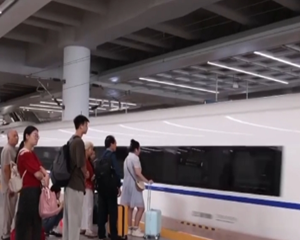The 3-day Mid-Autumn Festival holiday in China has wrapped up.
为期三天的中国中秋节假期已经结束。
The Ministry of Transport says cross-region passenger trips were expected to surpass 600 million, and that's an increase of 28% compared with a year ago.
交通运输部表示,假期期间,全社会跨区域客运量预计超过6亿人次,同比增长28%。
Official figures recorded 43 million trips on the railway lines and 5 million from aviation.
官方数据显示,铁路客运量为4300万人次,民航客运量为500万人次。
Data reveals road travel made up the majority of transport, with the travel by new energy vehicles exceeding half of that.
数据显示,公路出行占交通出行的大部分,其中新能源汽车出行占比超过一半。
New travel trends have emerged over the 3-day Mid-Autumn Festival holiday.
为期3天的中秋节假期出现了新的旅游趋势。
Telecom giant China Mobile's Wutong Big Data shows China's most popular destinations were Beijing, Guangzhou, Shenzhen, Chengdu and Xi'an.
电信巨头中国移动的梧桐大数据显示,中国最受欢迎的旅游目的地是北京、广州、深圳、成都和西安。

Niche locations experienced a surge in popularity as well based on passenger flows such as Jincheng, Jingdezhen, the Daxing' anling region and Qinhuangdao.
基于客流,晋城、景德镇、大兴安岭地区和秦皇岛等小众地点的人气也出现了激增。
China's younger Gen Z snapped up traditional Chinese night tours from the moon-viewing cruises to temple and lantern fairs.
中国年轻的Z世代青睐从赏月游船,到庙会和灯会的传统中式夜游。
Popular destinations included Beijing Garden Expo Park, Guangzhou Cultural Park and Hefei Luogang Park.
热门景点包括北京园博园、广州文化园和合肥骆岗公园。
Inbound tourism also saw significant growth increasing by 22% compared to the same period of last year driven in part by China's visa-free policy.
入境旅游人数也比去年同期增长了22%,部分原因是中国的免签证政策。
The largest increases came from Southeast Asia, Europe, and Africa.
其中,入境人数增幅最大的地区是东南亚、欧洲和非洲。



